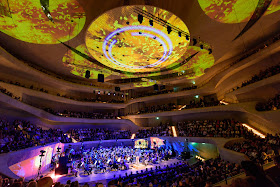 |
| Kristjan Järvi & Baltic Sea Philharmonic at the Elbphilharmonic (Photo (c) BMEF / Peter Adamik) |
 |
| The Elbphilharmonie, Hamburg (Photo © Iwan Baan) |
The Elbphilharmonie offers a concert-going experience like no other. Designed by the Swiss architecture firm of Herzog and de Meuron (which was responsible for Tate Modern in London), the Elbphilharmonie project was famously overrunning and costly. Work began in 2007, and was scheduled to be finished by 2010 with an estimated cost of €241 million; construction work officially ended in 2016 at a cost of €789 million. This was partly because of the technical complexity and architectural daring; putting a huge glass box on top of a huge existing brick warehouse, and suspending a concert-hall inside (in fact there are three concert halls, an hotel as well as apartments and, of course, a car park).
The result has great architectural élan, but what I want to consider is, 'Does the concert-going experience work?'.
 |
| The entrance escalator, Elbphilarmonie (Photo © Michael Zapf) |
You, the other audience members as well as members of the public, who are simply here for the view, are at plaza level. Not the top floor, the concert hall and recital room are above us. But here is The View, you can wander round the full scope of the building. A walk-way runs right round the building, though some of sections seem perilously narrow. You can buy food and drink; having a glass of wine whilst looking at the view seems very tempting, but the cafe/bar is too small to cope with the crowds and queuing is inevitable.
To get to the concert hall you ascend further, up a grand staircase; again this is an internal structure with no hint of views. Leaving the concert requires the reverse process, and an entire audience trying to do it together leads to an inordinate crush. Many follow the concert with a final drink and look at the view. The access might not make complete logistical sense, but it probably helps the bar takings.
The main concert hall (the Grosser Saal) is like a number of European concert halls, inspired by the Philharmonie in Berlin (from 1960-63, designed by Hans Scharoun) with its highly influential vineyard-style seating. The Elbphilarmonie is an irregular polygon with projecting balconies all around.
Here the walls are textured, the whole interior is like this and the texturing is acoustic, each shape is unique. This combined with the pale wood floors and the bronze railing makes for a very stylish look. But the upper balconies are perilous, the stairs steep and I would not recommend them for vertigo sufferers. Like the Barbican Theatre, the design ensures that people are never too far from the stage, but at the expense of the reassurance provided by a more substantial and regular, less precipitous balcony.
 |
| Grosser Saal, Elbphilharmonie (Photo © Iwan Baan) |
In many ways it reminded me of the old Covent Garden, a series of interlinked spaces with bars (and toilets) tucked away and requiring a knowledge of the geography to get the best of the experience. Certainly the cosy little bar nearest my seat (area Q, level 15) seemed unable to cope with demand at the interval. I was reminded of the way old Covent-Garden-hands would whisk you away to a hitherto unsuspected corner where a drink was more easily obtainable.
 |
| Grosser Saal Foyer, Elbphilharmonie (Photo © Iwan Baan) |
The sound quality is not strictly flattering, it requires real clarity of playing and probably takes some acclimatisation before an orchestra can utilise it at its best. Chatting to a local couple before the concert, they suggested that different types of ensemble and solo concert worked differently in the acoustic, with some better than others.
The Elbphilharmonie is a very distinct concert experience, you would not be anywhere else. But aspects of the design seemed to be there for design purposes rather than to make the concert-going experience better. Your concert going becomes part of an architectural statement.
Elsewhere on this blog:
- High quality music making enlivens an earnest view of Bach's Christmas Oratorio at St John's Smith Square - concert review
- Christmas roundup: our selection of this year's seasonal CDs - CD review
- Collegiate and celebratory, or perhaps Bach in party-mode: Mass in B minor from Solomon's Knot - concert review
- Narrative-based: Handel's Messiah from Academy of Ancient Music - concert review
- Innovation and charm: The Nutcracker and I, by Alexandra Dariescu - theatre review
- The familiar and the unfamiliar: The Sixteen at Christmas - concert review
- Small forces, big ideas: The Dunedin Consort in Bach's Christmas Oratorio from the Wigmore Hall - Concert review
- Tears are not far away: Andrew James Johnson's Winter's Heart - CD review
- Environmental sensuality & composing with sounds you cannot hear: I chat to DARE Art Prize winner Samuel Hertz - interview
- Buenos Aires by way of Edinburgh: Piazzolla's seductive Maria de Buenos Aires from Mr McFall's Chamber - CD review
- Sheer fun: Rimsky-Korsakov's Christmas Eve from Chelsea Opera Group - opera review
- Home

No comments:
Post a Comment